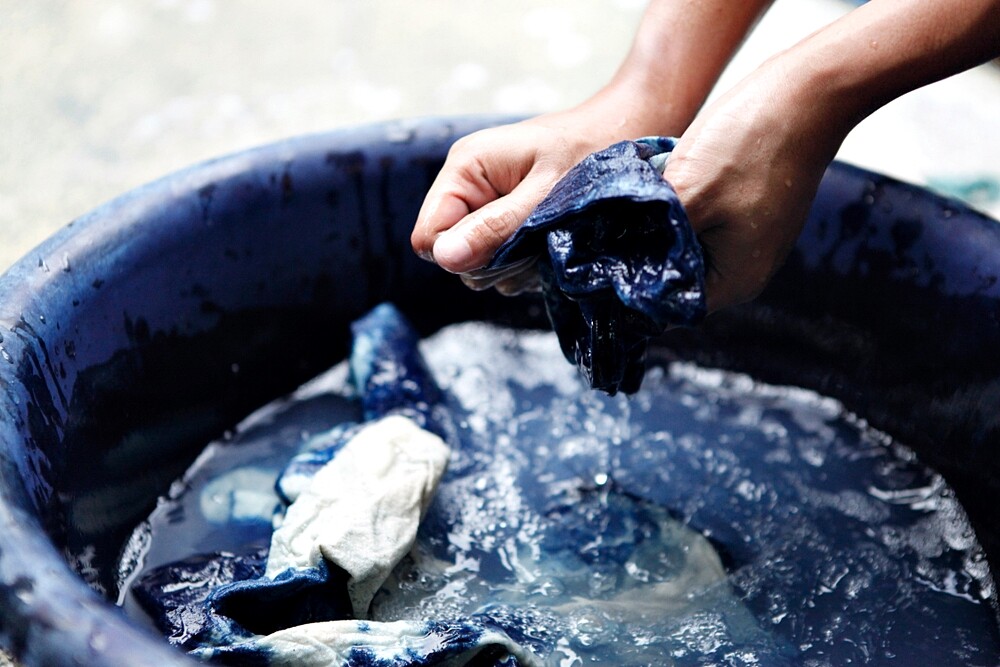To make your clothes shine in a new colour, you can simply use textile dye! How you can dye clothes and what you have to consider, you can find out here!
It doesn’t always have to be a new garment – sometimes it’s quite enough to refresh the colour of the clothes! Or did you get tired of the pure white dress? Even then, you can simply dye your textiles with another colour and set new accents! The reasons for dyeing are obvious:
- With little money you can give your clothes/textiles a new colour kick!
- Dyeing clothes is a form of upcycling, as you refresh the clothes and keep wearing them.
- With little effort, you can re-style your furniture or wardrobe to the colour of your choice.
Which fabrics can be dyed?
Before starting the actual dyeing process, you have to check the label to see which fibres have been used.
The following fabrics are suitable for dyeing:
- Linen/half linen
- Cotton
- Cellulose
- Viscose
- Blended fabric containing at least 60 % of the abovementioned fibres
The following fibres can be dyed with natural dyes or specially specified textile dyes:
- Silk
- Wool
These fibres do not absorb dyes:
- Polyamide
- Polyacrylic
- Polyester
- Acrylic
- Polyester
- Outdoor clothing that is equipped with Goretext or Sympatex
To dye clothes: You must know that!
- If you use textile color, the color selection always shows the result that is achieved with white fabric. If coloured textiles are dyed, the result is a mixed colour: For example, yellow fabric will turn green with blue textile colour.
- The more clothes and textiles you want to dye at once with the dye, the brighter the result will be.
- It may be that seams and zippers do not take on colour because they are made of synthetic fibres.
- Dark textiles can only be dyed with darker colours or alternatively bleached.
- Always dye light-colored clothing slightly darker than the original color.
- Use colouring salt to fix the colour.
- Mixed fabrics do not produce a strong colour result, but weaken the colour.
- With light and smooth fabrics you will achieve a better colour result.
Dyeing clothes: Preparations
- Wash clothes before dyeing (without fabric softener or hygiene rinse).
- The clothing must be free of stains!
- New textiles should already have been washed three times so that the surface treatments are washed out and the colour can be accepted.
- If you use dyes from the trade, they are only tendered for a certain weight of fabric. So weigh how many grams of fabric you have and adjust the dosage accordingly.
Dyeing clothes: By hand or machine?
Whether you use the washing machine to colour your laundry or carry out the process by hand in a bowl, both have their advantages and disadvantages.
Dyeing in the washing machine:
- Large quantities can be dyed in one load in the washing machine.
- The work is done by the washing machine.
- The colour intensity cannot be influenced.
Dyeing by hand:
- You can regulate the colour intensity yourself by the time of application.
- You need a large, washable container made of glass, plastic or enamel.
- You must protect yourself and your work area from paint splashes (protective gloves are mandatory, as well as smocks, foil, etc.).
Dyeing clothes in the washing machine
- When dosing the textile dye, follow the manufacturer’s instructions.
- In order for the dye to spread well, the washing machine may only be filled to a maximum of half its capacity.
- Moisten your clothes slightly before dyeing: It’ll give you a better result.
- Use the normal colored laundry program for dyeing. Short programmes do not provide enough time for the fibres to absorb the dye.
- When dyeing, also observe the maximum washing temperature of the garment (on the textile label).
- If you do not have coloring salt, you can use common salt.
- After dyeing, wash the clothes again with detergent (without fabric softener) to remove residual dye in the washing machine and on the clothes.
- If you do not like the result, you can repeat the dyeing process.
Dyeing clothes by hand
- When dyeing by hand, you need an appropriately large container and protective gloves.
- Use textile dye, which is also specified for dyeing in the bowl.
- Follow the manufacturer’s instructions when preparing the dye bath.
- Stir the paint in the water.
- Put your clothes into the dye bath, stir well and wait for the reaction time according to the manufacturer.
- After dyeing, wash the dyed garment once again in the machine at 40°C with detergent (without fabric softener).
Attention: You should not use a dryer for drying. Hang the laundry in a warm place instead.

